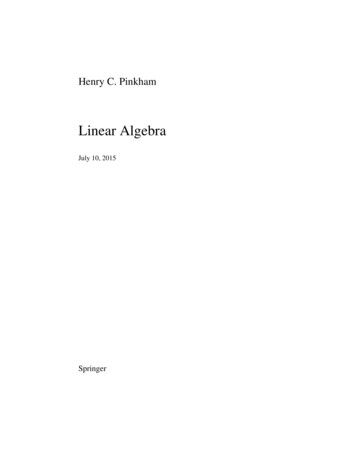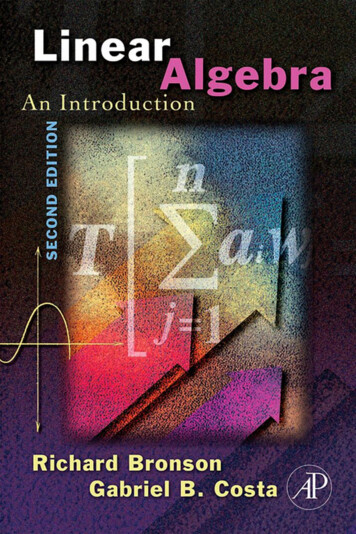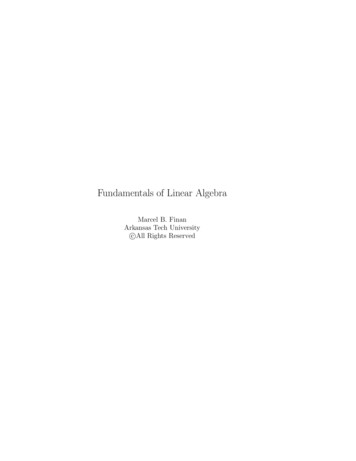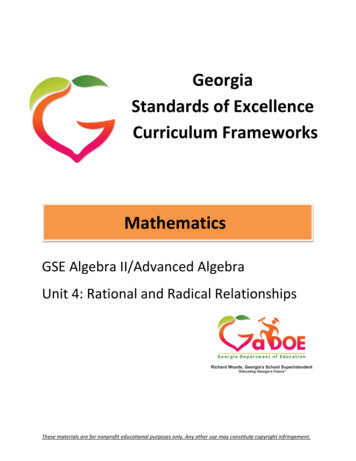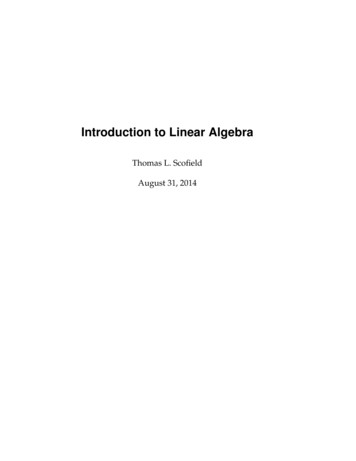
Transcription
Introduction to Linear AlgebraThomas L. ScofieldAugust 31, 2014
Contents1 Solving Linear Systems of Equations1.1 Matrices, and Introduction to Octave . . . . . . . . . . . . . . . . .1.2 Matrix Algebra . . . . . . . . . . . . . . . . . . . . . . . . . . . . .1.3 Matrix Multiplication and Systems of Linear Equations . . . . . .1.3.1 Several interpretations of matrix multiplication . . . . . .1.3.2 Systems of linear equations . . . . . . . . . . . . . . . . . .1.4 Affine transformations of R2 . . . . . . . . . . . . . . . . . . . . . .1.5 Gaussian Elimination . . . . . . . . . . . . . . . . . . . . . . . . . .1.5.1 Examples of the method . . . . . . . . . . . . . . . . . . . .1.5.2 Finding an inverse matrix . . . . . . . . . . . . . . . . . . .1.6 LU Factorization of a Matrix . . . . . . . . . . . . . . . . . . . . . .1.7 Determinants . . . . . . . . . . . . . . . . . . . . . . . . . . . . . .1.7.1 The planar case . . . . . . . . . . . . . . . . . . . . . . . . .1.7.2 Calculating determinants for n-square matrices, with n 21.7.3 Some facts about determinants . . . . . . . . . . . . . . . .1.7.4 Cramer’s Rule . . . . . . . . . . . . . . . . . . . . . . . . . .1.8 Linear Independence and Matrix Rank . . . . . . . . . . . . . . . .1.9 Eigenvalues and Eigenvectors . . . . . . . . . . . . . . . . . . . . .1161414192124253132363738424344492 Vector Spaces2.1 Properties and Examples of Vector Spaces2.1.1 Properties of Rn . . . . . . . . . . .2.1.2 Some non-examples . . . . . . . .2.2 Vector Subspaces . . . . . . . . . . . . . .2.3 Bases and Dimension . . . . . . . . . . . .777777798082.3 Orthogonality and Least-Squares Solutions3.1 Inner Products, Norms, and Orthogonality3.1.1 Inner products . . . . . . . . . . . .3.1.2 Orthogonality . . . . . . . . . . . . .3.1.3 Inner product spaces . . . . . . . . .3.2 The Fundamental Subspaces . . . . . . . . .3.2.1 Direct Sums . . . . . . . . . . . . . .95. 95. 95. 96. 99. 101. 101iii
Contents3.2.2Fundamental subspaces, the normal equations, and least-squaressolutions . . . . . . . . . . . . . . . . . . . . . . . . . . . . . . . . . . . 1034 Detailed Solutions to Exercisesiv113
1 Solving Linear Systems of Equations1.1 Matrices, and Introduction to OctaveDefinition 1: An m-by-n real matrix is a table of m rows and n columns of realnumbers. We say that the matrix has dimensions m-by-n.The plural of matrix is matrices.Remarks:1. Often we write a matrix A (ai j ), indicating that the matrix under considerationmay be referred to as a single unit by the name A, but that one may also refer to theentry in the ith row, jth column as ai j .2. If one of the matrix dimensions m or n is equal to 1, it is common to call the table avector (or column vector, if n 1; a row vector if m 1). Though column vectors arejust special matrices, it is common to use lowercase boldface letters for them (like u,v, x, etc.), reserving uppercase boldface letters for other types of matrices. When x isan n-by-1 vector, we often denote its components with singly-subscripted non-boldletters—x1 for the first component, x2 for the 2nd , and so on.Practitioners carry out large-scale linear algebraic computations using software, andin this section we will alternate between discussions of concepts, and demonstrations ofcorresponding implementations in the software package Octave. To create a matrix (orvector) in Octave, you enclose elements in square brackets ([ and ]). Elements on the samerow should be separated only by a space (or a comma). When you wish to start a newrow, you indicate this with a semicolon (;). So, to enter the matriceshi1 5 2 , 4 1 , 3 7and 3 0 1 5 , 2 1you can type/execute1
1 Solving Linear Systems of Equations octave [ 1 5 2]ans 15 2 octave [ 4 ; 1; 3 ; 7 ]ans 4 137 octave A [ 3 0 ; 1 5 ; 2 1 ] ;In all but the third of these commands, Octave echoed back to us its understanding ofwhat we typed. It did not do so for the last command because we ended that commandwith a final semicolon. Also, since we preceded our final matrix with “A ”, the resultingmatrix may now be referred to by the letter (variable) A.Just as writing A (ai j ) gives us license to refer to the element in the 2nd row, 1st columnas a21 , storing a matrix in a variable in Octave gives us an immediate way to refer toits elements. The entry in the 2nd row, 1st column of the matrix A defined above can beobtained immediately by octave A( 2 , 1 )ans 1That is, you can pick and choose an element from A by indicating its location in parentheses.One can easily extract whole submatrices from A as well. Suppose you want the entirefirst row of entries. This you do by specifying the row, but using a colon (:) in place ofspecifying the column. octave A ( 1 , : )ans 30Next, suppose we want to get the first and third rows of A. Since we want full rows here,we continue to use the colon where a column can be specified. We use a vector whoseentries are 1 and 3 to specify which rows. octave A( [ 1 3 ] , : )ans 3021There are some shortcuts in Octave when creating matrices or vectors with particularkinds of structure. The colon may be used between numbers as a quick way to create rowvectors whose entries are evenly spaced. For instance, a row vector containing the firstfive positive integers is produced by the command 2
1.1 Matrices, and Introduction to Octaveoctave 1 : 5ans 1 2 34 5 You can also specify a “step” or “meshsize” along the way, as in octave 1 : . 5 : 3ans 1.00001.50002.00002.5000 3.0000 One implication of the ability to create vectors in this fashion is that, if we wish to extractthe first two rows of the matrix A above, either of the commands or octave A( 1 : 2 , : ) octave A( [ 1 2 ] , : ) will do the trick. (Here and following, I have suppressed Octave’s output.)Sometimes we want matrices (a pair of them) that contain the coordinates of a meshconsisting of points in the plane. The meshgrid() command is useful for this purpose, asexhibited below. As you see, meshgrid() returns two matrices, not just one. In the examplewe graph a collection of points from a mesh in the xy-plane, along with the meshgrid()command generating x- and y-components for these points. Note that the contents of thematrix Y are flipped from what you might expect. octave [ X , Y] meshgrid ( 0 : 3 , 1 : . 5 : 3 )X 000001111122222 33333321Y 002.00002.50003.0000123 Aside: Suppose, above the region covered by our mesh, we want to view the surfacegiven by z x2 /y. You might use these commands (try them!). octave [ X , Y] meshgrid ( 0 : 3 , 1 : . 5 : 3 )octave Z X . ˆ 2 . / Yoctave mesh ( X , Y , Z) 3
1 Solving Linear Systems of EquationsYou may be able to place your mouse cursor over this plot, click-hold and rotate the figurearound to view it from various perspectives. As you view the plot, it will occur to youthat the surface would be more appealing if we used a finer mesh. As an exercise, tryreproducing this surface over the same region of the xy-plane, but with grid points (in thatplane) just 0.1 apart.A special class among the square matrices (i.e., those having equal numbers of rowsand columns) are the diagonal matrices. Such a matrix A (ai j ) is one whose entries ai jare zero whenever i , j. The diag() command makes it easy to construct such a matrix inOctave, even providing the ability to place specified entries on a super- or subdiagonal(i.e., a diagonal that lies above or below the main diagonal). We give here two examplesof the use of diag(). In the first case, the only argument is a vector, whose entries are thenplaced on the main diagonal of an appropriately-sized diagonal matrix; in the 2nd case,the additional argument of ( 1) is used to request that the vector of entries be placed onthe first subdiagonal. octave diag ( [ 1 3 1])ans 10003000 1octave diag ( [ 1 3 1] , 1)ans 00001000030000 10Other Octave commands that are helpful in producing certain types of matrices arezeros(), ones(), eye(), and rand(). You can read the help pages to learn the purposeand required syntax of these and other Octave commands by typinghelp command name at the Octave prompt. It is perhaps relevant to note that numbers (scalars) themselves areconsidered by Octave to be 1-by-1 matrices.The title of the next section is “Matrix Algebra.” Before we can dive into that, systemwe must know what one means by the word equality.Definition 2: Two matrices A (ai j ) and B (bi j ) are said to be equal if theirdimensions are equal, and if the entries in every location are equal.Example 1:4
1.1 Matrices, and Introduction to OctaveThe two vectorshi3 1 2 5and 3 1 2 5cannot be considered equal, since they have different dimensions. While the entriesare the same, the former is a row vector and the latter a column vector.Most programming languages can interpret the concept of “equal” in several ways, andOctave is no exception. A single equal sign is interpreted as assignment; when two equalssigns appear together, it is for the purpose of comparison. a 4a 7A rand ( 3 , 2 )a AB A;B(1 ,2) 4B AA rand ( 2 , 3 )%%%%%%%%x has been assigned the value o f 4c o m p a r i n g v a l u e i n x w i t h 7 ; r e t u r n s FALSEA i s a 3 by 2 m a t r i x w i t h v a l u e s g e n e r a t e dE r r o r : Cannot c o m p a r e e n t i t i e s o f d i f f e r e n tB h a s b e e n made t o b e i d e n t i c a l t o A(1 ,2) entry in B has been r e a s s i g n e d valueCompares t h e s e two m a t r i c e s e n t r y by e n t r yGuess a t t h e r e s u l t , t h e n v i e w t h e a n s w e r( value 0)randomly” types ”of 4 Some tips about the Octave language: The next examples demonstrate other relational operators. a a a 4a 477& b 4 b 4%%%%r e t u r n s TRUE ( 1 )r e t u r n s TRUE ( 1 )& is the l o g i c a l is the l o g i c a l i f the value in a i s unequal to 7i f the value in a i s at l e a s t 7AND o p e r a t o rOR o p e r a t o r When Octave encounters the percent symbol (%), the rest of the line is considered acomment. If you see an Octave command seemingly end in three dots ”.”, the commandactually carries over to the next line (with the dots ignored). If you perform, in succession, commands like C ones ( 4 , 5 )C [ 2 ; 1 ; 1] % C i s now a 4 by 5 m a t r i x o f a l l o n e s% C i s now a 3 by 1 v e c t o r w i t h s p e c i f i e d e n t r i e s Octave does not put up a fuss, but readily adapts from C being an entity holding20 double-precision values to one holding just three. When, however, you havea matrix B already in existence, and you assign one of its entries (or reassign, asoccurred above in the line reading “B(1,2) 4”), the size and shape of B do notchange.5
1 Solving Linear Systems of EquationsThe flexibility Octave has over what is stored in a variable comes from the factthat it determines variable type at the time of instantiation. Some people like thisfeature, while others (C enthusiasts?) consider it an open doorway to sloppyprogramming. Practically speaking, most variables are double-precision numbers,or matrices/vectors containing double-precision numbers. Octave is case-sensitive, as exhibited by the “a A” line above. One can designate the default way that numbers are printed. Values which are clearlyintegers may be printed with no trailing decimal and digits. The first time you startOctave, it will display non-integers with 4 digits to the right of the decimal point;very small numbers will be reported using scientific notation. Try the followingcommands to see how one can change this method of displaying numbers. piformat longpipi / 1 0 ˆ 6format r a tpiformat s h o r tpi % s m a l l number , u s e s s c i e n t i f i c n o t a t i o n% b e t t e r r a t i o n a l number a p p r o x t o p i t h a n 2 2 / 7% mode o f d i s p l a y f r o m when O c t a v e was f i r s tstarted There are ways, of course, to make Octave print a number with 6 (or some othernumber) decimal places, but that seems rather unimportant for now.In this course, the term vector will be synonomous with column vector. The set of vectorshaving n components, all of which are real numbers, will be called Rn , or sometimesEuclidean n-space. The elements of Rn are n-by-1 matrices, sometimes called n-vectors.However, as it takes less room out of a page to list the contents of a vector horizontallyrather than vertically, we will often specify an n-vector horizontally using parentheses, asinx (x1 , x2 , . . . , xn ) .1.2 Matrix AlgebraThe most fundamental algebraic operations on matrices are as follows:1. Addition of Two Matrices.Given two m-by-n matrices A (ai j ) and B (bi j ), we define their sum A B to bethe m-by-n matrix whose entries are (ai j bi j ). That is, a11 a12 · · · a1n b11 b12 · · · b1n a11 b11 a12 b12 · · · a1n b1n a b21 a22 b22 · · · a2n b2n a21 a22 · · · a2n b21 b22 · · · b2n : 21 . . . . . . . . . am1 am2 · · · amn bm1 bm2 · · · bmnam1 bm1 am2 bm2 · · · amn bmn6
1.2 Matrix AlgebraIn order to add two matrices, they must have the same number of rows and columns(i.e., be matrices with the same dimensions). Note that this is not the same as sayingthey must be square matrices!It is simple to add two matrices in Octave. One possibility is code like octave A [ 3 1 6 ; 1 2 1 ] ;octave A ones ( 2 , 3 )ans 427230 which creates a 2-by-3 matrix A, and then adds to it another 2-by-3 matrix whoseentries are all ones.2. Multiplication of a Matrix by a Scalar.Given an m-by-n matrix A (ai j ) and a scalar c, we define the scalar multiple cA tobe the m-by-n matrix whose entries are (cai j ). That is, ca11 ca12 · · · ca1n a11 a12 · · · a1n ca21 ca22 · · · ca2n a21 a22 · · · a2n c . . : . . . . cam1 cam2 · · · camnam1 am2 · · · amnOur definitions for matrix addition and scalar multiplication have numerous implications. They include the following:a) Matrix subtraction is merely a combination of matrix addition and scalar multiplication by (-1): A B : A ( 1)B.b) Distributive laws between matrix addition and scalar multiplication hold:i. c(A B) cA cB.ii. (c d)A cA dA.c) An appopriately-sized matrix whose entries are all zeros serves as an additive identity(or zero matrix, denoted in boldface by 0). That is, A 0 A.d) Scalar multiplication by 0 produces the zero matrix 0. That is, (0)A 0.In the lines of code below, we generate a 3-by-2 matrix whose entries are sampledfrom a normal distribution with mean 0 and standard deviation 1. To exhibit scalarmultiplication in Octave, we then multiply this matrix by 3. octave 3 randn ( 3 , 2 )ans 4.032393.048601.674422.604560.331312.31099 7
1 Solving Linear Systems of Equationswhich produces a 3-by-2 matrix whose entries are sampled from a normal distribution with mean 0 and standard deviation 1, and then multiplies it by the scalar3.3. Multiplication of Two MatricesWhen we multiply two matrices, the product is a matrix whose elements arise fromdot products1 between the rows of the first (matrix) factor and columns of the second.An immediate consequence of this: if A and B are matrices, the product AB makessense precisely when the number of columns in A is equal to the number of rowsin B. To be clearer about how such a matrix product is achieved, suppose A is anm-by-n matrix while B is an n p matrix. If we write r1 "# r2 c1 c2 · · · cp andB ,A . . rm with each of the rows ri of A having n components and likewise each of the columnscj of B, then their product is an m p matrix whose entry in the ith -row, jth -columnis obtained by taking the dot product of ri with cj . Thus if 2 1 "# 03 1 03 ,andB A 2 4 10 5 1 7 4then the product AB will be the 4 3 matrix"#" #"# 310 (2, 1) ·(2, 1) · (2, 1) · 2410 "#"#"# 310 (0, 3) ·(0, 3) · (0, 3) · 2410 "#"#"#AB 310 ( 5, 1) ·( 5, 1) ·( 5, 1) · 2410 "#" #"# 10 (7, 4) · 3(7, 4) ·(7, 4) · 2410 8 6 17 2918 2 10 12 30 . 1 10 9 40The dot product of two vectors is a concept from vector calculus, studied primarily in the case where thosevectors have just two components. It appears as well in elementary physics courses.
1.2 Matrix AlgebraRemarks: When we write AB, where A, B are appropriately-sized matrices, we will meanthe product of these two matrices using multiplication as defined above. InOctave, you must be careful to include the multiplication symbol (since AB is avalid variable name), as in octave A [ 1 2 3 ; 4 5 6 ] ;octave B [ 2 ; 3 ; 1 ] ;octave A Bans 1129 VectorizationThe manner in which we defined matrix multiplication is the standard (andmost useful, as you will see) one. Nevertheless, there are times one has numerous pairs of numbers to multiply. If, for each pair, one of the numbers isstored in a vector x with its counterpart stored in the corresponding location ofa vector y, one could use a for loop to achieve this; the Octave code would looksomething like this: v e c t o r S i z e length ( x )z zeros ( size ( x ) )for i i 1: vectorSizez( i i ) x( i i ) y( i i ) ;end % I assume y i s o f t h e same l e n g t h% c r e a t e s a v e c t o r z , same s i z e a s x This code cycles through the elements of the vectors x and y one at a time, sothe processing time of this loop increases as the length of the vectors increase.In one test conducted by the author, the processing time was 0.00554 s whenthe vectors were of length 500, but had jumped to 4.156 s for vectors of length500,000.As it is not rare for datasets to contain millions of values these days, we seeka way to speed up such computations. In Octave, the solution is to vectorizethe calculations. Without getting into the details, this essentially means thesoftware performs all of the calculations—products, in this case—in parallel,performing them componentwise. We tell Octave to carry out componentwiseoperations simultaneously on all elements of the vectors in question using thedot (.) symbol. You witnessed one example of this sort of vectorization inthe “Aside” of the previous section, when I demonstrated a 3D plot using themesh() command. We can vectorize the lines of code above (loop and all) withthis single command: z x . y;% c r e a t e s z and s t o r e s i n i t p r o d u c t s f r o m x , y 9
1 Solving Linear Systems of EquationsIt really does make a difference; when the vector sizes were 500,000 in my testrun, this vectorized code took 0.003328 s of processing time (as compared with4.156 s when similar calculations were done in the for loop).The reader should try creating two vectors of the same length (say, 10-by-1),perhaps using commands like x unidrnd ( 2 5 , 1 0 , 1 ) which will fill the vector x with randomly-selected integers in the range 1–25.If your two vectors are called x and y, then experiment with various non-dot(unvectorized) and dot (vectorized) versions of calculations, such asnon-vectorizedx yx - yx * yx / yx ˆ 3vs.vectorizedx . yx .- yx .* yx ./ yx .ˆ 3See if you can explain the differences (or lack thereof) in results, or why somecommands do not work at all. (Cudos to you if you can figure out how tointerpret the result of ”x / y”.) As it turns out, the same dot notation tellsOctave to perform operations componentwise for matrices as well as vectors—that is, if we “dot-multiply” matrices A, B (perhaps like the two below on theleft side of the equals sign), we get the componentwise result (as displayed onthe right side of the equals sign):"# "# "#a bα βaα bβ. c dγ δcγ dδThis explains what is happening in the code of the “Aside” (last section). Donot think of this as matrix multiplication (which was defined above, and yieldsquite different results), nor as a dot product, but rather as the simultaneouscalculation of many products using vectorization.Conveniently, most every mathematical function built into Octave’s mathematical library vectorizes its calculations. That is, you can obtain the values of thesine function simultaneously for all inputs stored in x by simply asking forthem: sin ( x )exp (A)log ( y )sqrt (B)%%%%o u t p u t i s v e c t o r o f same s i z e a s xe x p o n e n t i a t e s every element in At a k e s natural log o f every element in yt a k e s square root o f every element in B Notice that, if A is 4-by-2 and B is 2-by-3, then the product AB is defined, but theproduct BA is not. This is because the number of columns in B is unequal to the10
1.2 Matrix Algebranumber of rows in A. Thus, for it to be possible to multiply two matrices, oneof which is m-by-n, in either order, it is necessary that the other be n-by-m. Evenwhen both products AB and BA are possible, however, matrix multiplication isnot commutative. That is, AB , BA, in general. We do have a distributive law for matrix multiplication and addition. In particular, A(B C) AB AC, for all appropriately-sized matrices A, B, C. When an m-by-n matrix A is multiplied by an n-by-1 (column) vector (an nvector, for short), the result is an m-vector. That is, for each n-vector v, Avis an m-vector. It is natural to think of left-multiplication by A as a mapping(or function) which takes n-vectors v as inputs and produces m-vectors Avas outputs. Of course, if B is an -by-m matrix, then one can left-multiplythe product Av by B to get B(Av). The manner in which we defined matrixproducts ensures that things can be grouped differently with no change in theanswer—that is, so(BA)v B(Av) . Notice that the n-by-n matrixIn 1 0 : 0 . . 00 0 ···1 0 ···0 1 ···. . . . .0 0 ··· 0 0 0 . . 1has the property that, whenever C is an n-by-p matrix (so that the product In Cmakes sense), it is the case that In C C. Moreover, if B is an m-by-n matrix, thenBIn B. Since multiplication by In does not change the matrix (or vector) withwhich you started, In is called the n-by-n identity matrix. In most instances, wewill write I instead of In , as the dimensions of I should be clear from context.In Octave, the function that returns the n-by-n identity matrix is eye(n). Thisexplains the result of the commands octave A [ 1 2 3 ; 2 3 1]A 12323 1octave A eye ( 3 )ans 12323 1 11
1 Solving Linear Systems of Equations For a square (n-by-n) matrix A, there may be a corresponding n-by-n matrix Bhaving the property thatAB BA In .If so, the matrix A is said to be nonsingular or invertible, with inverse matrixB. Usually the inverse of A, when it exists, is denoted by A 1 . This relationshipis symmetric, so if B is the inverse of A, then A is the inverse of B as well. If Ais not invertible, it is said to be singular.The following fact about the product of invertible matrices is easily proved.Theorem 1: Suppose A, B are both n-by-n invertible matrices. Thentheir product AB is invertible as well, having inverse (AB) 1 B 1 A 1 .When A is invertible, it is not so easy to find A 1 as one might think. Withrounding (and sometimes instability) in the calculations, one cannot, in general,get a perfect representation of the inverse using a calculator or computer, thoughthe representation one gets is often good enough. In Octave one uses the inv()command. octave A [ 1 2 3 ; 2 3 1; 1 0 2]A 12323 110 2octave B inv (A)B 0 . 6 6 6 6 7 0.44444 0.333330.555560 . 3 3 3 3 3 0.222221.22222 0.777780.11111octave B Aans 1 . 0 0 0 0 0 .00000 4. Transposition of a MatrixLook closely at the two matrices 2 0 1 1 A 3 1 1 1 2 2 0 112and 1 3 2 2 1 2 B 10 0 1 1 1
1.2 Matrix Algebrafor a connection between the two. The matrix B has been formed from A so thatthe first column of A became the first row of B, the second column of A becamethe 2nd row of B, and so on. (One might say with equal accuracy that the rows ofA became the columns of B, or that the rows/columns of B are the columns/rowsof A.) The operation that produces this matrix B from (given) matrix A is calledtransposition, and matrix B is called the transpose of A, denoted as B AT . (Note:In some texts the prime symbol is used in place of the T , as in B A0 .)When you already have a matrix A defined in Octave, there is a simple command thatproduces its transpose. Strictly speaking that command is transpose(). However,placing an apostrophe (a prime) after the name of the matrix produces the tranposeas well, so long as the entries in the matrix are all real numbers (i.e., having zeroimaginary parts). That is why the result of the two commands below is the same forthe matrix A on which we use them. octave A [ 1 2 3 ; 2 3 1]A 12323 1 octave t r a n s p o s e (A)ans 12233 1 octave A’ans 12233 1 Remarks: If A is an m-by-n matrix, then AT is n-by-m. Some facts which are easy to prove about matrix transposition are the following:(i) For all matrices A it is the case that (AT )T A.(ii) Whenever two matrices A and B can be added, it is the case that (A B)T AT BT .(iii) Whenever the product AB of two matrices A and B is defined, it is the casethat (AB)T BT AT .(Compare this result to Theorem 1, a similar-looking fact about the inverseof the product of two invertible matrices.)(iv) For each invertible matrix A, AT is invertible as well, with (AT ) 1 (A 1 )T .13
1 Solving Linear Systems of Equations There are some matrices A for which AT A. Such matrices are said to besymmetric.1.3 Matrix Multiplication and Systems of Linear Equations1.3.1 Several interpretations of matrix multiplicationIn the previous section we saw what is required (in terms of matrix dimensions) in orderto be able to produce the product AB of two matrices A and B, and we saw how to producethis product. There are several useful ways to conceptualize this product, and in this firstsub-section we will investigate them. We first make a definition.Definition 3: Let A1 , A2 , . . . , Ak be matrices all having the same dimensions. Foreach choice of real numbers c1 , . . . , ck , we callc1 A1 c2 A2 · · · ck Aka linear combination of the matrices A1 , . . . , Ak . The set of all such linear combinationsS : {c1 A1 c2 A2 · · · ck Ak c1 , . . . , ck R}is called the linear span (or simply span) of the matrices A1 , . . . , Ak . We sometimeswrite S span({A1 , . . . , Ak }).Here, now, are several different ways to think about product AB of two appropriatelysized matrices A and B.1. Block multiplication. This is the first of four descriptions of matrix multiplication,and it is the most general. In fact, each of the three that follow is a special case ofthis one.Any matrix (table) may be separated into blocks (or submatrices) via horizontal andvertical lines. We first investigate the meaning of matrix multiplication at the blocklevel when the left-hand factor of the matrix product AB has been subdivided usingonly vertical lines, while the right-hand factor has correspondingly been blockedusing only horizontal lines.14
1.3 Matrix Multiplication and Systems of Linear EquationsExample 2:Suppose 8 8 3 4 5 A 6 6 1 8 6 5 3 4 2 7 ih A1 A2 A3 (Note how we have named the three blocks found in A!), and 3 5 5 2 2 2 2 7 B1 03 B2 .B 6 6 3 2 5 0 B3 0 1 1 4ThenAB A1 B1 A2 B2 A3 B3 # 3 8 8 "i 4 3 5 5 2 h 1 6 6 0 3 8 6 6 2 2 2 7 245 3 8 24 24 72 18 18 0 9 12 13 30 42 42 30 6 6 0 3 24 22 6 3 24 24 0 12 9 19 19 31 14 29 9 43 12 26 8 57 . 39 40 36 9 #5 " 3 2 5 06 0 1 1 47 15 20 34 24 17 28While we were trying to keep things simple in the previous example by drawing onlyvertical lines in A, the number and locations of those vertical lines was somewhatarbitrary. Once we chose how to subdivide A, however, the horizontal lines in B hadto be drawn to create blocks with rows as numerous as the columns in the blocks ofA.Now, suppose we subdivide the left factorSay that A11 A A21 A31with both horizontal and vertical lines.A12A22A32 . Where the vertical line is drawn in A continues to dictate where a horizontal linemust be drawn in the right-hand factor B. On the other hand, if we draw any vertical15
1 Solving Linear Systems of Equationslines in to create blocks in the right-hand factor B, they can go anywhere, paying noheed to where the horizontal lines appear in A. Say that"B B11 B12 B13 B14B21 B22 B23 B24#.Then A11 A12 " B11AB A21 A22 B21A31 A32 A11 B11 A12 B21 A21 B11 A22 B21 A31 B11 A32 B21B12 B13 B14B22 B23 B24#A11 B12 A12 B22 A11 B13 A12 B23 A11 B14 A12 B24A21 B12 A22 B22 A21 B13 A22 B23 A21 B14 A22 B24A31 B12 A32 B22 A31 B13 A32 B23 A31 B14 A32 B24 . Example 3:Suppose A, B are the same as in Example 2. Let’s subdivide A in the following(arbitrarily chosen) fashion: 8 8 3 4 5 A 6 6 1 8 6 5 3 4 2 7 "# A11 A12 . A21 A22Given the position of the vertical divider in A, we must place a h
1 Solving Linear Systems of Equations 1.1 Matrices, and Introduction to Octave Definition 1: An m-by-n real matrix is a table of m rows and n columns of real numbers. We say that the matrix has dime

